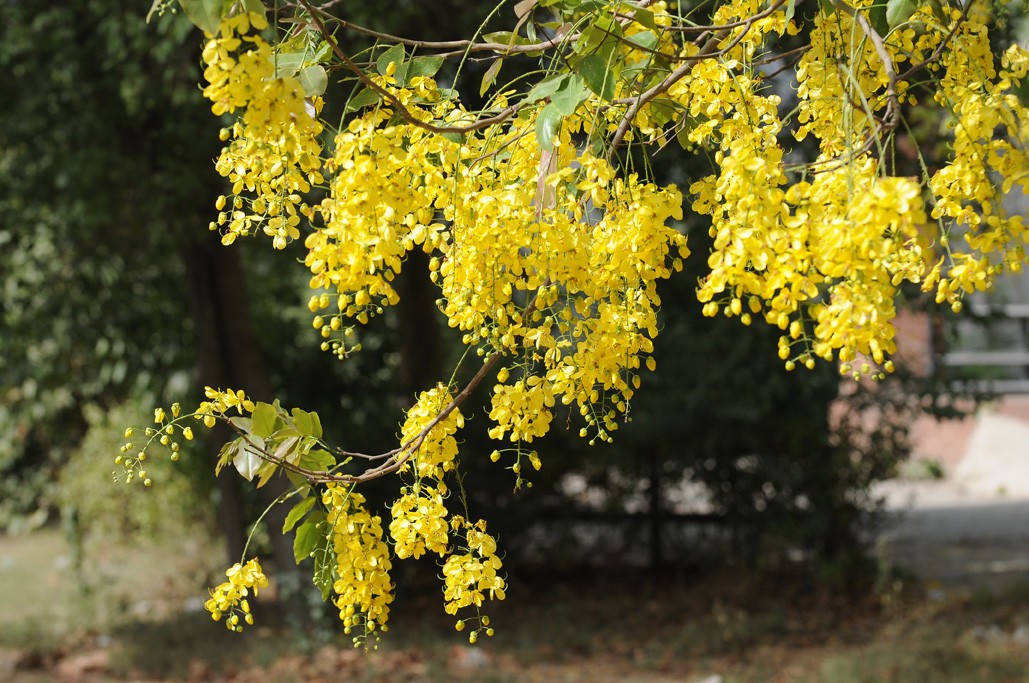
Supposing we plant a few hundred amaltas trees in parks or along lakes, and celebrate an annual Amaltas Blossom Festival?

My good friend Murtaza Solangi spent some of his long journalistic years in Washington DC. There, he says, he waited through those harsh winters for the cherry blossom to break out on the borders of the lake or pond or whatever that body of water is. He asked me if I had ever seen it, but the nearest I’ve been to DC was when I was briefly in New York three decades ago. It is in May, says Murtaza, that they have their Cherry Blossom Festival, a great binge of gaiety, song, dance, food and drink.
Murtaza says that these trees were gifted to DC by the Japanese emperor at the end of World War I. This is not the fruit-bearing species, just the flowering one and its sole purpose is to bring beauty and colour to the landscape. The Japanese have long had the original cherry blossom festival and when I checked Google, I discovered that several US and Canadian cities now follow the Washington DC model.
Murtaza asked why we couldn’t have similar festivals here. Blessed as we are with so many flowering trees that mark the advent of our long hot summers, we could do a similar fest. He suggested jacaranda with its glorious violet blossoms. But then jacaranda, native to Central South America and the Bahamas, was naturalised to India about a hundred years ago. What we have instead is the magnificent amaltas, a native of the blessed subcontinent.
As May draws upon us with its blistering hot winds and dust, amaltas leaves turn brown and fall off with every windstorm. Why, even as I sit here writing, my little garden is strewn with sere leaves of my backyard amaltas. By next week, it will be naked. As May rises, pendulous shoots tipped with tiny green globules will break out on the bare, scraggy branches. Soon we will have what I have always called a ‘flowerfall’ -- a waterfall of golden blossoms.
But unlike the cherry tree, we have a fragrance to outdo the beauty of the blossoms.
But wait, I am hard put to resolve if the amaltas is a visual stunner or an olfactory treat. It is both, for as I stand under this tree abloom I am struck in turn by its physical beauty and the delicate perfume it exudes. I wonder how long it will take our perfumers to extract and capture in a bottle this celestial fragrance.
Supposing we plant a few hundred amaltas trees in, say, Race Course Park (or along Rawal Lake as Murtaza suggests) and celebrate an annual Amaltas Blossom Festival? Given all the doom and gloom (except for the stars of Panama Leaks) we poor commoners are sorely in need of celebration. A flower festival with the colour of gold (aah, gold!) and a fragrance that comes straight from some non-existent paradise is just what we could do with.
I know festivals of any sort, any show where people can let their hair down and have a blast -- oops, sorry, no blasts, please -- have some decent fun are really not kosher in today’s Pakistan. We banned Basant, remember? But for that we had the readymade excuse that it was a Hindu festival celebrating the god Vasanta. Though I’ve heard of the sohanjna (Moringa oleifera) tree being referred to as a ‘Hindu tree’, even the most diehard obscurantist will have some difficulty assigning religion to the amaltas.
Meanwhile, we’ll have a few years of fun and joy under amaltas gold.
Surely, if we institute an Amaltas Blossom Festival, it should not take long for us -- even with our blighted vision -- to learn more about sohanjna and perhaps begin a festival for this blessed tree as well.
Twenty years ago, long before the Rangers forbade free travel in the Thar Desert, my friend Marvin Parvez and I overnighted with our common chum, Khet Singh of Sonal Wah east of Mithi. Reclining on charpoys under a starry sky with the deep, metallic call of the eagle owl our only music, we talked of the various trees that grow in the desert. The kundi (Prosopis cineraria) came under discussion. I had already known that they made a curry from its protein-rich seed pod, but it was only then that Khet Singh told me another thing: during famine, they milled the bark of the kundi and cooked wholesome chapattis with it.
I said to my friend that in this case one ought to worship a tree like the kundi. I loved Khet Singh’s response, "When we utilise the kundi as we do, it is the same as worshipping it."
So, while for aesthetics we have amaltas, the sohanjna -- known to the thinking world as the Tree of Life, Miracle Tree etc -- can be our giver of life. So few in Pakistan know today that its leaves are fortified multi-vitamin and mineral tablets!
If the Japanese and the North Americans can celebrate their flowering trees, I fail to see why we must languish in the bane of useless exotic species. But as I said to my friend Murtaza Solangi, it is impossible to implant a sensible idea in the minds of the controllers of Pakistan’s destiny. That is a task inversely proportionate to the speed with which foolishness takes root and grows strong in the same minds.